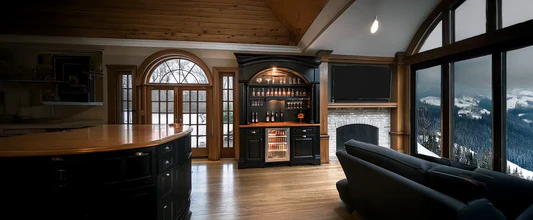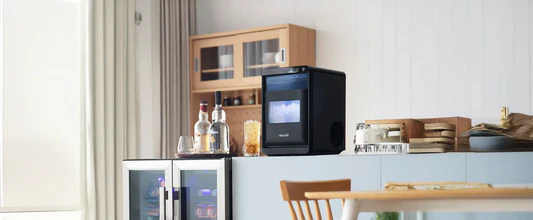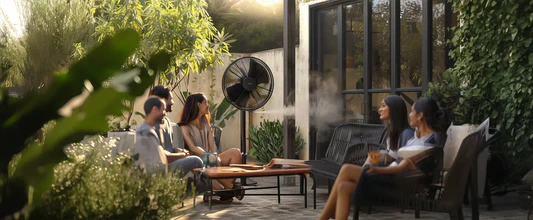Proper wine storage isn’t just about keeping bottles organized—it’s essential for preserving and enhancing their taste, whether you’re planning to enjoy them soon or save them for later.
In this guide, we offer:
- Techniques for long-term wine storage and aging
- Tips for short-term wine storage and entertaining
- The benefits of wine fridges and how they help store all types of wine effectively
With these tips, your collection will be in top condition for every occasion.
Long-Term Wine Storage and Aging
We’ll cover wine storage for entertaining in the next section. But first, let’s focus on storing wine you don’t plan to drink for a while. Maybe you brought back a few cases from a recent trip to Italy or France, or you have new bottles you’d like to age to enhance their flavor as they mature.
Your winemaker or vendor can help you decide whether your wine is ready to enjoy now or would benefit from more time in the bottle. Under the right conditions, many fine wines can last for decades in storage. So, if you’re saving or aging wine, what should you consider for the best results?
Keep the Cork Moist
Many wines are still sealed with corks, though some winemakers have shifted to screw tops for cost effectiveness or sustainability. For cork-sealed bottles, it’s important to keep the cork moist to preserve the wine’s quality.
The best way to do this is by laying the bottle horizontally in a wine rack or a wine fridge with horizontal shelving, rather than storing it upright. This position keeps the wine in contact with the cork, preventing it from drying out. A dry cork can crack, allowing oxygen and odors to seep in, which accelerates aging and can spoil the taste.
Most wine experts recommend storing bottles with the label facing up. This position helps any sediment settle on the opposite side of the label, preserving the wine’s appearance if you plan to present it before serving.
Control Air Temperature, Light, and Humidity
Oxygen is just one of several factors that can harm wine. Extreme heat, freezing temperatures, direct sunlight, and improper humidity—whether too high or too low—can all negatively impact a wine's quality.
Many people new to wine collecting store bottles on top of the refrigerator or in a warm closet, but these areas can damage the cork, shorten the wine’s lifespan, and alter its flavor. The ideal storage temperature for wine is around 57 degrees Fahrenheit, making a basement a good option if you have one.
Otherwise, a wine fridge may be your best choice. A dual-zone wine fridge is even better, allowing you to set two different temperatures in a single appliance: one zone for long-term storage and another for wines you plan to drink soon, which may need a slightly different temperature. Red wines, for example, are best stored between 55 and 65 degrees Fahrenheit, while white wines are typically served cooler, between 42 and 55 degrees depending on the type. This setup helps ensure each wine reaches its ideal serving temperature and preserves its quality over time.
Humidity is another factor you want to control. As mentioned above, corks need a humid environment to stay moist, but too much moisture can promote mold growth on bottle labels. Experts recommend a humidity level around 65 percent for balanced wine storage.
Finally, limiting exposure to sunlight is essential. Ultraviolet light can quickly degrade wine, affecting its color, aroma, and flavor. A dark storage space like a wine fridge is ideal.
While you might consider storing wine in a regular refrigerator, typical kitchen refrigerators are too cold for long-term storage, and the humidity levels may not be ideal. Plus, with more than a few bottles, space in a standard fridge can quickly become an issue.
Avoid Damage, Movement, and Vibration
Some people store their wine in the garage. This can work temperature-wise, as long as it doesn’t get too hot or too cold. However, the risk of bumping your collection or exposing it to vibrations—which can disturb sediment—makes a garage less than ideal. Similarly, laundry rooms pose these hazards and aren’t the best choice for wine storage. This is one reason many collectors prefer a dedicated wine fridge.
Short-Term Wine Storage for Entertaining
What about when you’re going to be serving wine soon? There are a few solutions you can use to achieve the perfect temperature.
You could move a bottle from your wine rack to your kitchen refrigerator. This works if you want the wine to be cooler than it is in storage. Wine lovers sometimes do this for whites, sparkling wines, rosés, and some light reds.
Another option is to allow the bottle to sit at room temperature for an hour or two. This is best if you need the wine to be a bit warmer than its storage conditions, such as with full-bodied reds.
However, one of the simplest solutions is to use a wine fridge. A wine fridge allows you to keep wine at the perfect temperature until you’re ready to serve. If you opt for a dual-zone wine fridge, you can take advantage of the two temperature zones in one of two ways:
- Use one zone for storing wine long-term and the other for wine you plan to serve soon.
- Use one side for whites and the other for reds.
Features to Look for in a Wine Fridge
Wine fridges today come with a range of features designed to cater to all types of wine drinkers, from casual enthusiasts to serious collectors. When choosing a wine fridge, consider the following options.
Types of Wine Fridges
First, you can choose between a built-in or a freestanding model. The latter is great for renters and for people who want the option to move their wine fridge to different spots in the house. You might normally keep a small wine fridge in the kitchen but switch it to a room where you entertain for holidays and special occasions.
Size Options
Next, you’ll find a variety of sizes. Select anything from a compact countertop model that stores six bottles to a wine fridge that accommodates 160 bottles.
In between, enjoy different shapes and sizes to fit in any space of your home, from ultra slim models to square or rectangular ones.
Key Features to Look For
Plus, check out these features for added environmental control and convenience:
- Exterior Finishes: Different exterior finishes for wine fridges, such as black or stainless steel, provide aesthetic appeal that complements your interior decor, including kitchen appliances, while also offering practical benefits, such as ease of cleaning and resistance to fingerprints and smudges.
- Adjustable Racks: With adjustable racks, you can customize the interior layout based on your collection's specific needs. This feature makes it easy to accommodate bottles of varying sizes and shapes, from standard wine bottles to larger specialty bottles. Additionally, the ability to modify the configuration of the racks enhances organization, making it easier to find and retrieve your favorite wines without hassle.
- Angled Display Shelving: This design not only enhances visibility, making it easier to identify and select your favorite bottles, but also promotes proper storage by keeping labels facing outward. This prevents potential damage to the labels from contact with other bottles and provides a more attractive presentation. Additionally, angled shelves can improve air circulation within the fridge, ensuring that each bottle is stored at the optimal temperature for preservation and enjoyment.
- Smooth-Rolling Beechwood Shelves: Unlike metal or plastic shelves, beechwood naturally absorbs and releases moisture, helping to regulate humidity within the fridge. This helps keep corks from drying out and protects the wine from oxidation. The smooth, soft surface also makes it easy to slide out and access bottles without jostling the rest of the collection.
- Fingerprint-Resistant, Mirrored Glass Doors: These doors are designed to resist smudges and fingerprints, keeping the surface clean and polished with minimal maintenance—a great benefit for high-traffic areas or households where the fridge is frequently accessed. Many mirrored glass doors are also treated to block harmful UV rays, with the mirror coating providing an extra layer of protection against light exposure to help preserve the wine’s flavor and aroma over time.
- Built-in Control Panel: An external display allows you to easily adjust temperature settings, monitor humidity levels, and control interior lighting with a simple interface, ensuring that your wine is stored under optimal conditions. Additionally, some models may include alarms or alerts for temperature fluctuations, giving you peace of mind that your collection is well protected.
- Ultra-Quiet Thermoelectric Cooling: Thermoelectric cooling is energy-efficient and environmentally friendly, typically consuming less power and containing no harmful refrigerants. With minimal vibration and noise, these systems are ideal for placement in living spaces, such as kitchens, dining rooms, or home theaters.
Many models also come with dual-zone options for greater temperature control for different types of wine. With these features in mind, you can find the perfect wine fridge to suit your needs.
Newair Makes Wine Storage Easy
Newair has a wide array of wine fridges with all the features listed above. We’re a US-based company that takes pride in our customer service and are always available to answer any questions you have about our various makes and models.
Be sure to check out our other compact appliances that make entertaining a breeze. From portable ice makers to pizza ovens to humidors, Newair has what you need for hosting with style!









